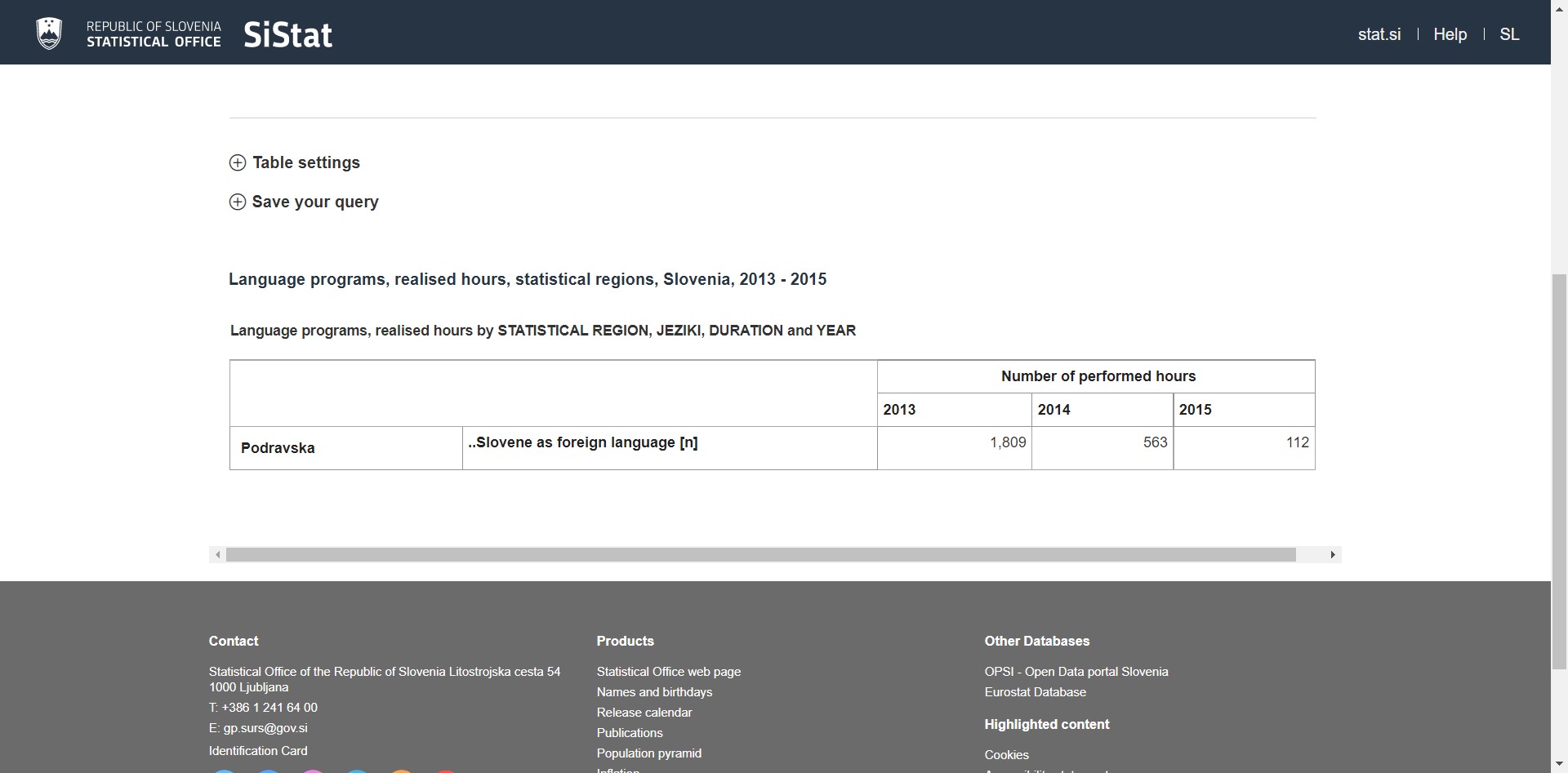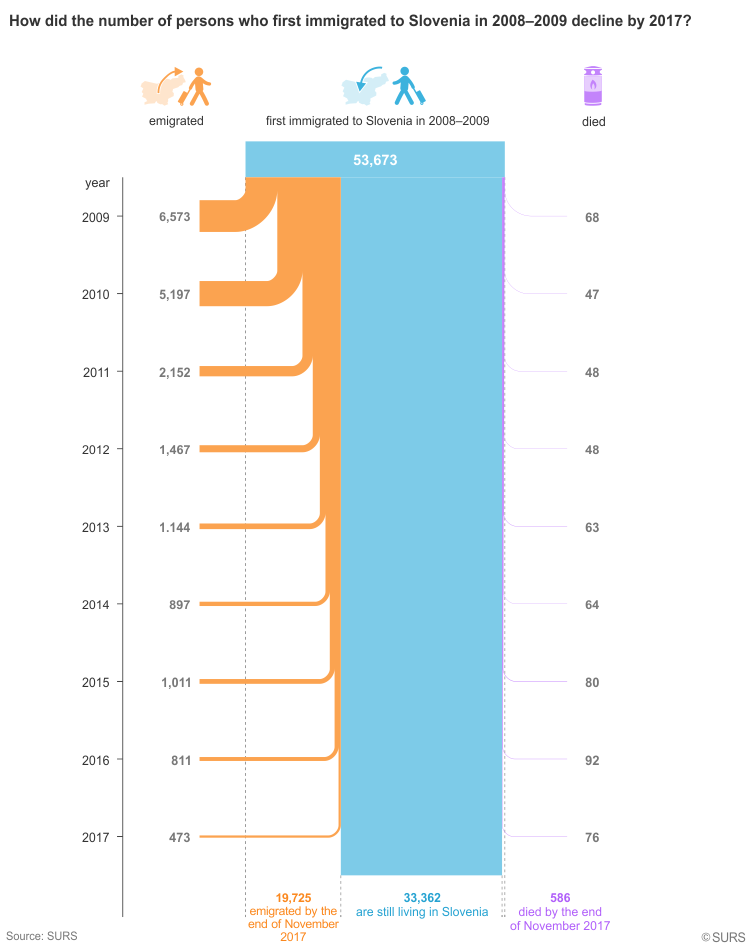
THE PUPILS
Using official statistics, the Complainant tried to compare Slovenia's throughput of new residents with its Slovene language teaching resources [41].
In a generously conservative computation of NSMTs
from the patchy statistics available, Slovenia's teaching firms have 54%* of
15.7%** of 2086214 residents (live count 11 June 2022 [42])
and therefore an estimated 176869 potential customers.
*not naturalised or foreign-born citizens - see below
**93% of 16.9 - see below
Is this a rationale for having an anti-English law in Slovenia?
Recall, the ZRSZ subscribed to the idea of a 180 hour Level A1 course.

Locally, there were 2484 teaching hours in all 2013-2015, and this is less than 16 hours per week.
In 2015 Podravska it was 2 hours and 9 minutes per week. These quantities are for all the pupils, remember.
Attention is drawn to the fact that the hours reported for Zahodna Slovenija, added to those for the Osrednjeslovenska region, are more than the total for each year for the whole of Slovenia in the first row and none of the totals in row 1 agree with the component data.
According to the table, a total of 34918 hours were provided in all years and
regions combined, while the total for Slovenia as a whole was a more modest
15959.
In a reversal of the 10% teacher inflation rate at the national level [41],
2.18 times more teaching hours by region were reported than the national total.
Using:
- the inflated 2021 official national teacher total of 208
- the bloated unofficial 2013-2015 regional total of hours performed of 34918
- the conservative estimate of 176869 potential pupils waiting to join the economy as of June 2022
...each 2021 teacher has 850 potential 2022 pupils.
...each 2013-15 teacher averaged 34918 hours/1095.75 days*7/208 = 4.27 hours per week.
...each of 2013-15's potential pupils could have expected 34918/208/1095.75*7*60*60/176869 = 0.021828473545247 seconds of individual attention per week, rising inversely with class takeup; so with 99% non-attendance, 2.18 seconds a week, and up to 1 hour/week if only 1 in 1649 of the NSMTs and 100% of the teachers are interested.
Herded into classes of 30, these elite NSMTs might therefore achieve their A1 after a patient 180 weeks.
But universal education of the NSMTs would require 1,061,214 hours even in classes of 30, and so at the sedate pace calculated above, a leisurely 3,365,726,026 years or so to reach A1, about a quarter of the age of the Universe.
Excitingly, this could benefit Slovenia's educonomy by almost 1.7 billion euros, excluding inflation, 50 cents a year.
But note certain class sizes do not suit the Slovenian ethos, as the idea of modern types of foreigner cooperating "secretly" (i.e. not in Slovene) to succeed in anything at all creates suspicion and nervousness. [80]
A one-to-one ratio arouses the Slovenians' worst fears: intimacy, empathy and a general terror of meeting people sober, so cost-efficiency arguments are used to stop that. Therefore the ideal class size from the perspective of the teacher of Slovene is more than one, but less than outnumber you.
Anything that might bring aliens together, except as tourists, will be deemed culturally inappropriate.
Usually, Slovenians obtain more efficient suction by splitting their free foreigners up: each one can then talk simultaneously, and to fewer people. [80]
But in this case there just aren't enough teachers who want to charge NSMTs for Slovene lessons so they can practice their English, and it would take a billion times more of them to do it a billion times faster.
A MORE REFINED APPROACH
By 2021 the Statistical Office was saying:
"...among 169,000 foreigners in 2021, there were just under 7% who were actually
born in Slovenia and were statistically not considered immigrants." [40]
Moreover:
"Among the 2,108,977 residents of Slovenia as of 1 January 2021, 292,824 or
13.9% were born abroad. That means that they immigrated to Slovenia at some
point. Among them, 46% were citizens of Slovenia: some of these were born as
such (for example they were born to Slovenian citizens who lived abroad), while
some acquired Slovenian citizenship through naturalisation." [40]
Neither of these guarantee any experience of Slovene, so ignoring this 46% and
this 7% in
the calculation could significantly underestimate the potential NSMT population.
How many - if any - of the remaining 158125 (54%) immigrants include Slovenian speakers is
still impossible to determine, and hence also the contrary. Most of those
depending on English are in there somewhere.
Even since 2002 the statisticians have never really gained full focus on this
uncomfortable topic. The statistics dance around the English quantity but never
confront it head on.
Reporting in December 2017 - with a diagram - the news that two out of three who
immigrated to Slovenia in 2008-9 were still there, the stats reveal
that:

"2,600 (5%) foreigners acquired citizenship, 85% of them are still living in
Slovenia. So citizenship of the host country is the factor with negative
influence on further international mobility."
What? The statistics on offer are something of a jumble sale. But as the period
of this particular statistical enthusiasm includes that for which teaching hours
data are available we can compare Slovenia's 2008/9 immigrants with the 15959
hours performed in 2013-2015, by which time the survivors must surely have been
ready for their citizenship, and see that makes 5320 hours per year on average,
just over 100 hours of teaching time a week for all the immigrants.
Of course 2008/9 was not the only year there was immigration to Slovenia. Those
who left or died were replaced and more.
37514 (70%) of the 2008/9 intake had not left or died by 2015 [40].
Annual teaching hours available to the 2600 new citizens among the arrivals of
2008/9 are therefore estimated at 5320/2600 = 2.05 hours per pupil per year.
Taking the 2008/9 arrivals left by 2015 as a whole, 5320/37514 is 0.142 hours
per pupil per year, which is eight and a half minutes.
Whereas looking at the whole 100% (of the 54%) present in 2021, 5320/158125
gives a result of 0.034 hours taught per conservatively estimated NSMT, which is
about two minutes per year.
And indeed this is pretty much the maximum amount of time 99% of Slovenians do
spend discussing their language, not counting the hours they waste on urging you
to do it, telling you you can't do it, telling each other you refuse to do it, and dvojina.
A fundamental aspect of this "urging" is that you learn it somewhere else.
[80]
The 83.1% version [11]
obviously implies what Eurydice says, that there were 16.9% NSMTs - including
the unknowns - amounting to up to 1 in 6 in Slovenia channeled into the
Uiberreither zone, and the
concomitant potentially illegal activity of trying to stay alive without speaking Slovene.***
Thus the ZJRS delivers a legally vulnerable
cohort of helpless non-belongers, a philosophy identical in its effect to
Uiberreither's.
The ZJRS criminalises the foreign-sounding victims of its own inefficacy, who
can be penalised at the whim of any indigenous pedant.
We could take 7% [40]
off that 16.9% and it would still be 15.7%. "People live here for decades
without learning Slovene," is a popular refrain, delivered in a tone somewhere
between pride, resignation and resentment, perpetuating a popular fundamental
attribution error, found all over the place.
Slovenians surprised and offended about this have
no difficulty also being surprised and offended at any suggestion they are
something to do with it.
Loyalties are flexible.
English can be both worshipped and dismissed, depending on
whether you are wearing your sophisticated cosmopolitan hat or your peasant
conformity hat.
Often dependent upon whether others are observing them in the throes of
Anglophilia, they do not seem to know whether to grovel or get aggressive with
the English incursion, and the answer is neither. [80]
BLACK TO THE FUTURE
"The population of Slovenia increased by 13,116
in 2020. The number of citizens of Slovenia increased by just over 800, while
the number of foreign citizens increased by 12,300. The share of foreign
citizens in the population was 8.0% on 1 January 2021." says SURS. [99]
But this shows the futility of first conflating births and immigration, and then
ignoring the emigration rates of mother tonguers as a component of the
demography. This "separate story" belongs on a different page:
"In 2020, every week 111 Slovenian citizens and 228 foreigners emigrated from
Slovenia
"In 2020, more than 36,100 people immigrated to Slovenia, while more than 17,700
emigrated. Positive net migration was partly due to administrative changes in
the population register." [104]
A moment's non-Slovenianness will reveal to you that this last statement is
untrue. Nobody's fact of arriving or leaving was altered by these mysterious
changes in ways of counting.
So instead of trying to make the number smaller by using weeks instead of years,
5772 mother tonguers left in 2020.
This politicised way of presenting it might suit, for instance, a
number-cruncher whose job is to alert the nation about swarms of NSMTs who can't
work legally, but is simultaneously duty-bound to play down any statistics about
Slovenians leaving, to avoid encouraging a stampede involving such aspirations,
mostly in the young, and the language death which would result.
Putting it together, 32.7% of those emigrating (or deregistering) are mother
tonguers. Arrivals, who cannot deal with business clients due to not being
ZJRS-14-compliant, are 93.7% NMSTs.
Slovenians do not, of course, go abroad to start Slovene-speaking ghettos as
there are not enough of them, and certainly not enough on the same side.
Then there is SURS' other page, which states:
"In 2020, 18,767 children were born in Slovenia."
and
"Fertility below the population replacement level is characteristic for
Slovenia. The total fertility rate in 2020 was 1.60." [103]
How do the 18767 births fit in with the 2020 population rise of 13116?
Are we to conclude by juxtaposing these items of information that 18767 minus
"just over" 800 - in other terms 95.7% of the babies - were not citizens of
Slovenia but the partly or wholly NSMT progeny of the 12300 non-citizen incomers
and their predecessors from earlier years?
We hope Slovenia does not have a 30% infant mortality rate. So, did 5651 babies
immediately leave the country before being registered as Slovenian?
Slovenia's arithmetical blancmange wobbles on, as SURS continues meandering
carefully around anything which might produce a precise quantification of NSMTs
with "57% of children born to unmarried mothers" and "13% mothers with foreign
citizenship". [103]
It is concluded that between 1 in 33 [9]
and 1 in 6 [11]
either do not or would prefer not to speak Slovene. At least 1 baby in 7.69 is
being born into ZJRS-based economic apartheid [103].
At least, because some have NSMT fathers too.
In 2022's NPZ (National Knowledge Test) the average in Slovene was 45.5%, and 63.5% in English. This proves the exams are too difficult, say the teachers. [59]
*Eurydice moved
quickly to solve the problem, disappearing this page sometime between the
appearance of this voy.si page - first
archived on 23 June 2022 - and 27 July, which is why I organised all the pages
referred to here to be archived. As you can still see, Eurydice also claimed,
somewhat contrary to its 83.1% figure, that Slovene is the mother tongue of 88%
of Slovenia's residents.